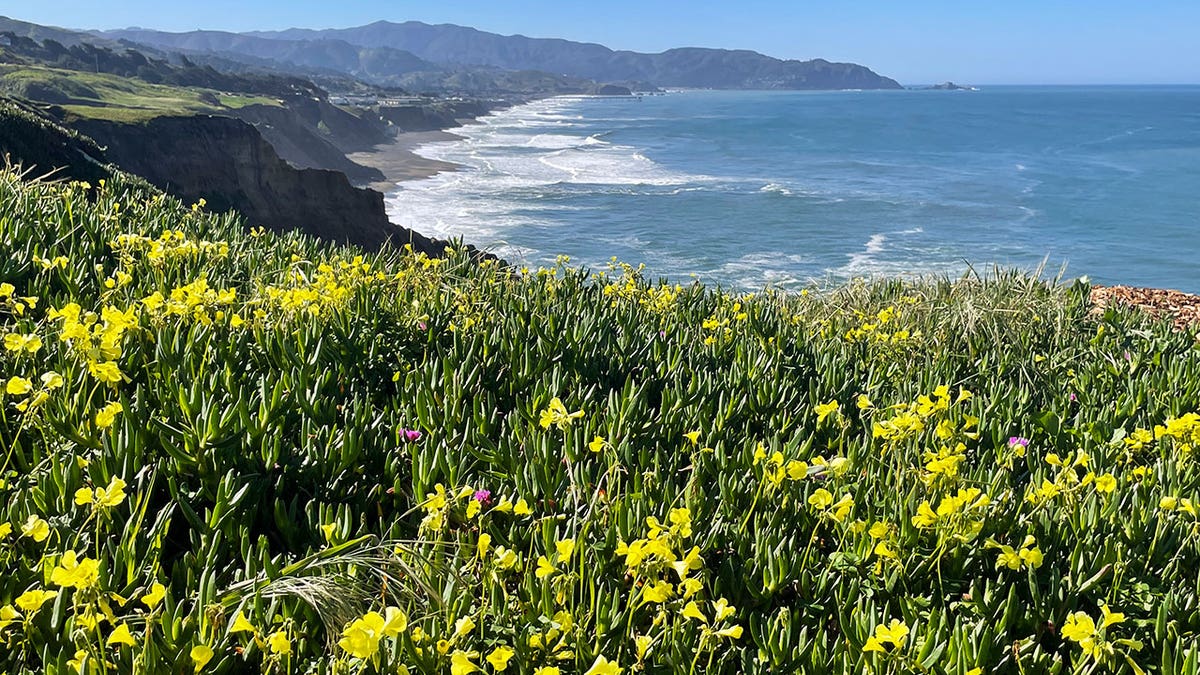Rare California superbloom caught on video: See the stunning views
A pilot with the U.S. Air Force took a stunning video of flower blooms in Southern California. The video shows flowers blooming near the Edwards Air Force base.
- Carpets of yellow, orange and gold flowers are spreading across Southern California's deserts.
- This year's blooms are not as vibrant or abundant as last year's "superbloom," which followed drought-busting rains.
- Superblooms occur when desert stretches transform into dense wildflower fields due to dormant seeds germinating after seasons with over 30 percent average precipitation.
Carpets of yellow, orange and gold flowers are beginning to cover Southern California's vast deserts, the Bay Area's dramatic bluffs and even near Los Angeles International Airport.
But do they add up to a "superbloom"? There is no single definition of the event, but so far this year's blooms haven't been as vibrant or abundant as those that took over swaths of California last spring following drought-busting rains. This year, too, the state received ample winter rains.
After especially wet winters, bursts of color may appear in the spring, drawing droves of visitors to California and other parts of the Southwest to glimpse the flowering fields and pose for pictures.
CALIFORNIA'S MASSIVE SUPERBLOOM SEEN FROM SPACE FOLLOWING HISTORIC, DROUGHT-ENDING RAINS
Here are some key facts about the natural spectacle.

Overlooking the Pacific Ocean, flowers bloom in Mussel Rock Park in Daly City, California, on April 1, 2024. Carpets of tiny, rain-fed wildflowers known as "superblooms" are appearing in parts of California and Arizona. Their arrival draws droves of visitors who stop to glimpse the flashes of color and pose for pictures. (AP Photo/Haven Daley)
WHAT'S A SUPERBLOOM?
Scientists don't agree on any one definition. Across California and Arizona, there are stretches of desert that can quickly transform into dense fields of wildflowers, since seeds lie dormant in the soil and then germinate and blossom at around the same time.
A recent study found that such widespread blooms, which have been visible by satellite imagery in some years, take place after seasons with greater than 30% average precipitation, said Naomi Fraga, director of conservation programs at the California Botanic Garden, east of Los Angeles.
DOES THIS YEAR COUNT?
No, according to Fraga. That's because there isn't a huge diversity in the flowers that have blossomed in places like California's Death Valley.
This year's blooms aren't as large or as dense as wildflowers in past years, she said.
"When I think of superblooms, I think of a bloom that is so extraordinary, that’s a once in a lifetime event," Fraga said, adding that the wildflower display this year "still makes a beautiful show."
Last spring, early April visitors to Southern California's Antelope Valley California Poppy Reserve were treated to dazzling orange displays of the state flower. But around the same time this year, the fields were absent of the orange blooms, with the reserve's officials posting that the window for an impressive show was becoming "increasingly narrow."
In Death Valley, one of the driest places on earth, stretches of desert are dotted with gold thanks to sunflowers that emerged after an especially wet winter and spring.
Whether that constitutes a superbloom is "really in the eye of the beholder," said Evan Meyer, executive director of the California-based nonprofit Theodore Payne Foundation, which works to preserve California's native plants.
WHEN DOES IT HAPPEN?
April is typically the peak month for spring wildflowers, but in high-elevation places they can continue to blossom later into the spring.
Superblooms generally refer to low-elevation desert regions, Fraga said.
"It's much more geographic than seasonal," Meyer said. "Spring in the mountains hasn’t started, and in the low desert, it’s past its peak."
When temperatures rise in the desert, the flowers can quickly dry out.
HOW DOES CLIMATE CHANGE AFFECT THE SUPERBLOOM?
Experts say it might be too soon to tell.
Climate change is making precipitation patterns more erratic, but the effects on wildflowers could play out over decades or even centuries, Fraga said, since seeds stay dormant in the soil for long periods of time.
CLICK HERE TO GET THE FOX NEWS APP
Southern California received heavy rain last summer, unlike its usually dry summers, which she said probably stimulated flowers to germinate out of season. Winter temperatures also were higher than average, so many of them were able to stay in bloom through the spring season.
"That made for a very unusual bloom," Fraga said.


